University Essay: Indigenous Education and Perspectives in Australia
VerifiedAdded on 2023/06/07
|12
|3068
|416
Essay
AI Summary
This essay delves into the historical event of the Stolen Generation in Australia, analyzing its profound impact on Indigenous communities and the subsequent implications for education. The paper examines the assimilation policies enforced by the Australian government, which led to the forced removal of Indigenous children from their families, causing intergenerational trauma and cultural disruption. It explores the perspectives of educators in early childhood settings and emphasizes the importance of understanding the historical context to foster culturally sensitive and supportive learning environments. The essay highlights the role of educators in promoting reconciliation, addressing the sensitive issues related to the Stolen Generation, and providing resources to help Indigenous children. The essay also discusses the Narragunnawali program and its contribution to reconciliation in schools and early learning, emphasizing the need for a comfortable environment when introducing sensitive topics. The conclusion stresses the importance of cultural competence and understanding to support Indigenous children and communities.
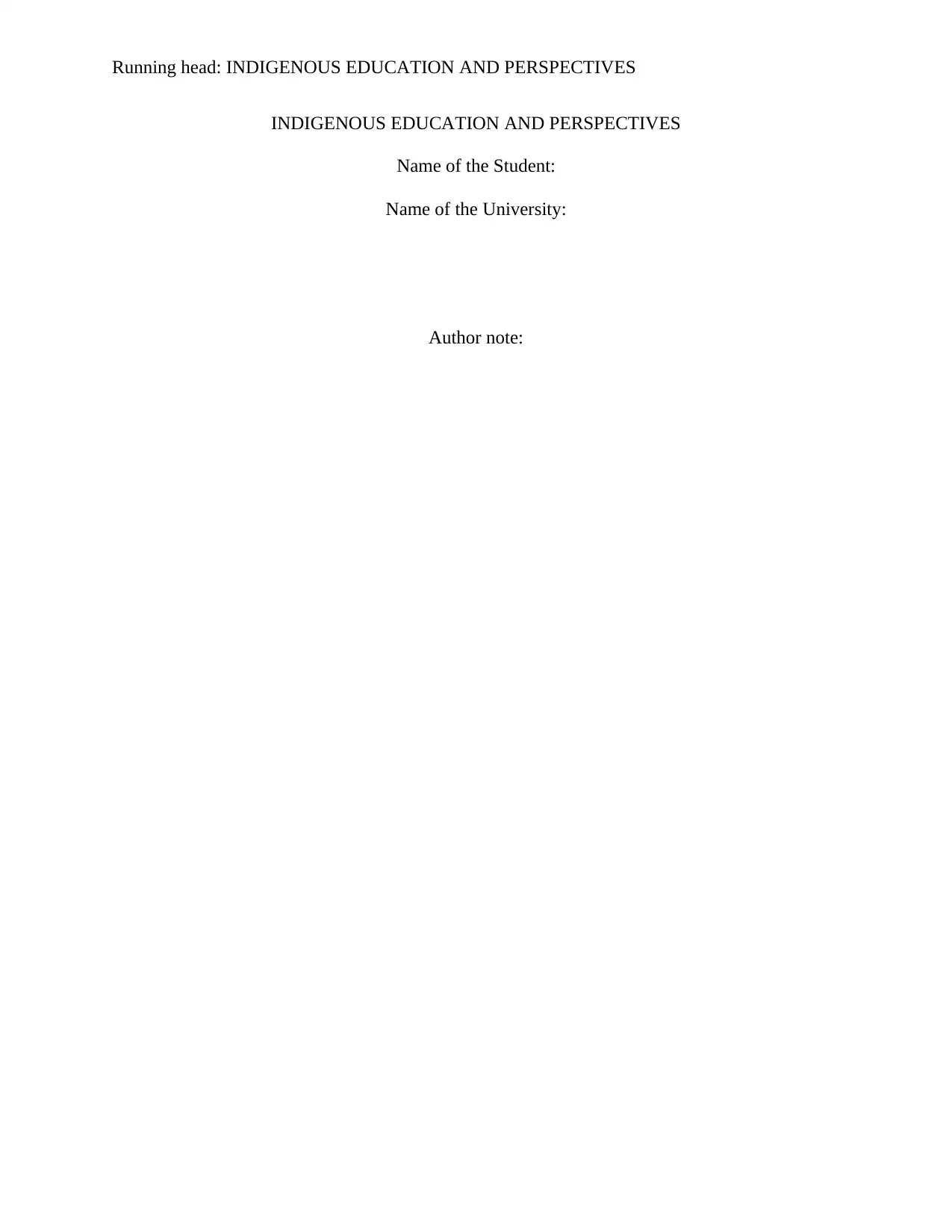
Running head: INDIGENOUS EDUCATION AND PERSPECTIVES
INDIGENOUS EDUCATION AND PERSPECTIVES
Name of the Student:
Name of the University:
Author note:
INDIGENOUS EDUCATION AND PERSPECTIVES
Name of the Student:
Name of the University:
Author note:
Paraphrase This Document
Need a fresh take? Get an instant paraphrase of this document with our AI Paraphraser
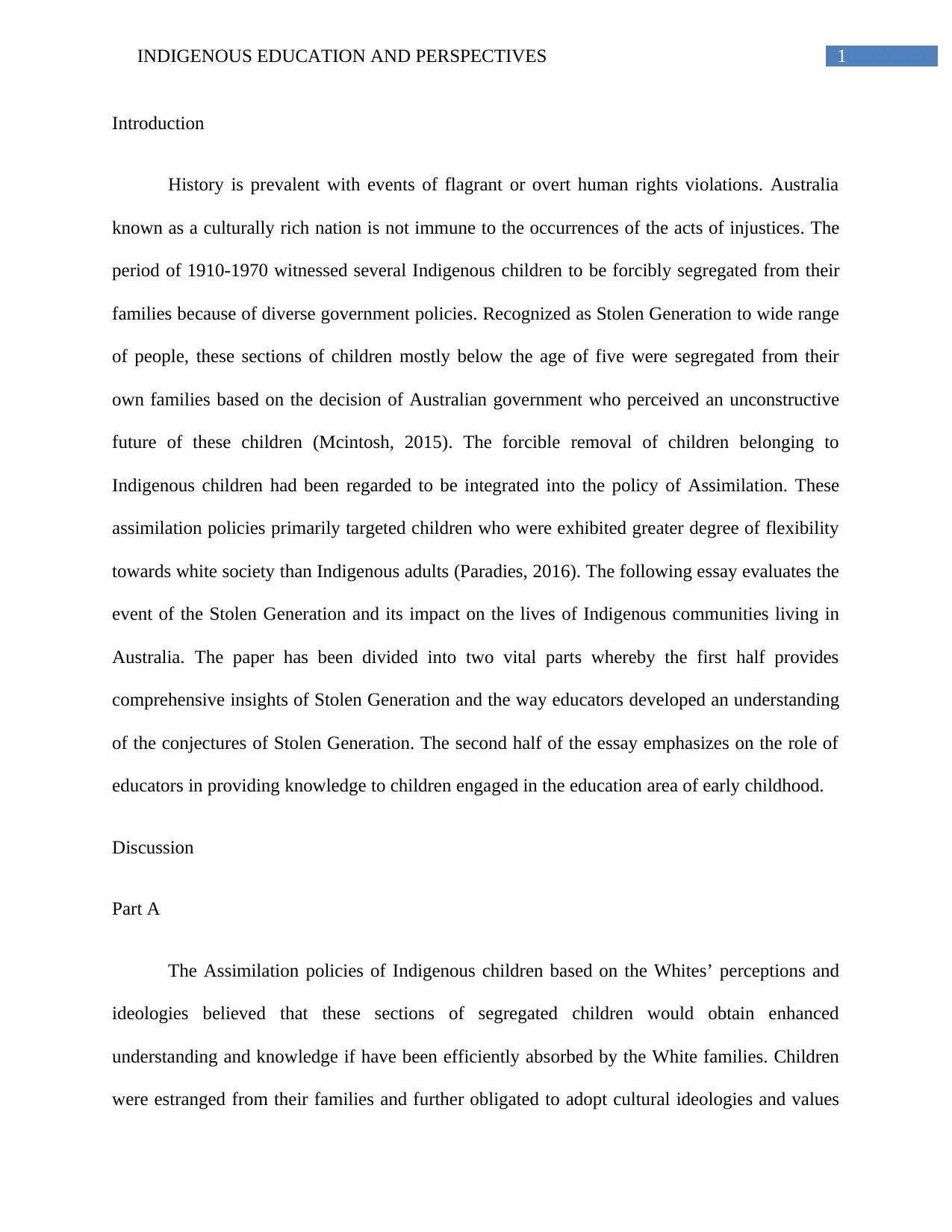
1INDIGENOUS EDUCATION AND PERSPECTIVES
Introduction
History is prevalent with events of flagrant or overt human rights violations. Australia
known as a culturally rich nation is not immune to the occurrences of the acts of injustices. The
period of 1910-1970 witnessed several Indigenous children to be forcibly segregated from their
families because of diverse government policies. Recognized as Stolen Generation to wide range
of people, these sections of children mostly below the age of five were segregated from their
own families based on the decision of Australian government who perceived an unconstructive
future of these children (Mcintosh, 2015). The forcible removal of children belonging to
Indigenous children had been regarded to be integrated into the policy of Assimilation. These
assimilation policies primarily targeted children who were exhibited greater degree of flexibility
towards white society than Indigenous adults (Paradies, 2016). The following essay evaluates the
event of the Stolen Generation and its impact on the lives of Indigenous communities living in
Australia. The paper has been divided into two vital parts whereby the first half provides
comprehensive insights of Stolen Generation and the way educators developed an understanding
of the conjectures of Stolen Generation. The second half of the essay emphasizes on the role of
educators in providing knowledge to children engaged in the education area of early childhood.
Discussion
Part A
The Assimilation policies of Indigenous children based on the Whites’ perceptions and
ideologies believed that these sections of segregated children would obtain enhanced
understanding and knowledge if have been efficiently absorbed by the White families. Children
were estranged from their families and further obligated to adopt cultural ideologies and values
Introduction
History is prevalent with events of flagrant or overt human rights violations. Australia
known as a culturally rich nation is not immune to the occurrences of the acts of injustices. The
period of 1910-1970 witnessed several Indigenous children to be forcibly segregated from their
families because of diverse government policies. Recognized as Stolen Generation to wide range
of people, these sections of children mostly below the age of five were segregated from their
own families based on the decision of Australian government who perceived an unconstructive
future of these children (Mcintosh, 2015). The forcible removal of children belonging to
Indigenous children had been regarded to be integrated into the policy of Assimilation. These
assimilation policies primarily targeted children who were exhibited greater degree of flexibility
towards white society than Indigenous adults (Paradies, 2016). The following essay evaluates the
event of the Stolen Generation and its impact on the lives of Indigenous communities living in
Australia. The paper has been divided into two vital parts whereby the first half provides
comprehensive insights of Stolen Generation and the way educators developed an understanding
of the conjectures of Stolen Generation. The second half of the essay emphasizes on the role of
educators in providing knowledge to children engaged in the education area of early childhood.
Discussion
Part A
The Assimilation policies of Indigenous children based on the Whites’ perceptions and
ideologies believed that these sections of segregated children would obtain enhanced
understanding and knowledge if have been efficiently absorbed by the White families. Children
were estranged from their families and further obligated to adopt cultural ideologies and values
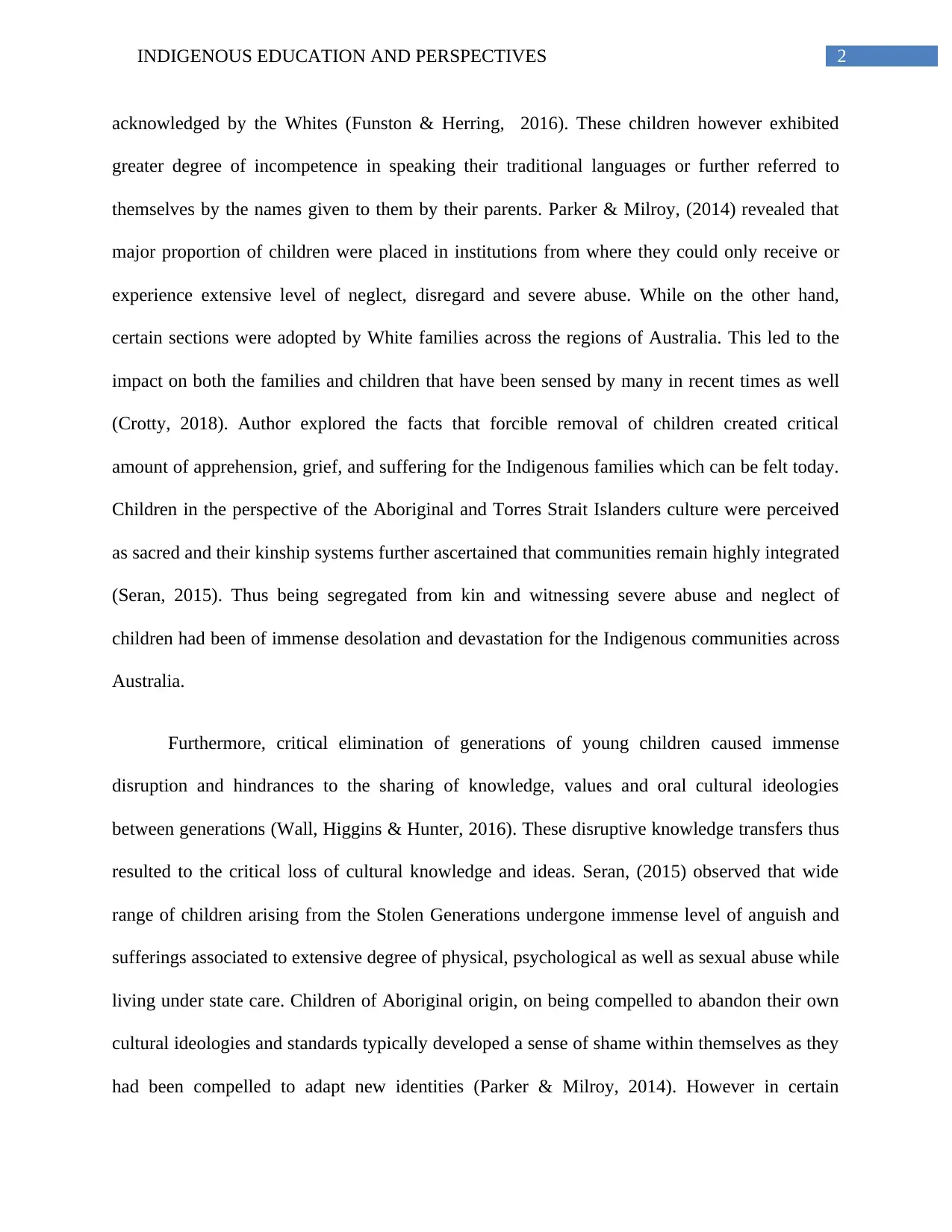
2INDIGENOUS EDUCATION AND PERSPECTIVES
acknowledged by the Whites (Funston & Herring, 2016). These children however exhibited
greater degree of incompetence in speaking their traditional languages or further referred to
themselves by the names given to them by their parents. Parker & Milroy, (2014) revealed that
major proportion of children were placed in institutions from where they could only receive or
experience extensive level of neglect, disregard and severe abuse. While on the other hand,
certain sections were adopted by White families across the regions of Australia. This led to the
impact on both the families and children that have been sensed by many in recent times as well
(Crotty, 2018). Author explored the facts that forcible removal of children created critical
amount of apprehension, grief, and suffering for the Indigenous families which can be felt today.
Children in the perspective of the Aboriginal and Torres Strait Islanders culture were perceived
as sacred and their kinship systems further ascertained that communities remain highly integrated
(Seran, 2015). Thus being segregated from kin and witnessing severe abuse and neglect of
children had been of immense desolation and devastation for the Indigenous communities across
Australia.
Furthermore, critical elimination of generations of young children caused immense
disruption and hindrances to the sharing of knowledge, values and oral cultural ideologies
between generations (Wall, Higgins & Hunter, 2016). These disruptive knowledge transfers thus
resulted to the critical loss of cultural knowledge and ideas. Seran, (2015) observed that wide
range of children arising from the Stolen Generations undergone immense level of anguish and
sufferings associated to extensive degree of physical, psychological as well as sexual abuse while
living under state care. Children of Aboriginal origin, on being compelled to abandon their own
cultural ideologies and standards typically developed a sense of shame within themselves as they
had been compelled to adapt new identities (Parker & Milroy, 2014). However in certain
acknowledged by the Whites (Funston & Herring, 2016). These children however exhibited
greater degree of incompetence in speaking their traditional languages or further referred to
themselves by the names given to them by their parents. Parker & Milroy, (2014) revealed that
major proportion of children were placed in institutions from where they could only receive or
experience extensive level of neglect, disregard and severe abuse. While on the other hand,
certain sections were adopted by White families across the regions of Australia. This led to the
impact on both the families and children that have been sensed by many in recent times as well
(Crotty, 2018). Author explored the facts that forcible removal of children created critical
amount of apprehension, grief, and suffering for the Indigenous families which can be felt today.
Children in the perspective of the Aboriginal and Torres Strait Islanders culture were perceived
as sacred and their kinship systems further ascertained that communities remain highly integrated
(Seran, 2015). Thus being segregated from kin and witnessing severe abuse and neglect of
children had been of immense desolation and devastation for the Indigenous communities across
Australia.
Furthermore, critical elimination of generations of young children caused immense
disruption and hindrances to the sharing of knowledge, values and oral cultural ideologies
between generations (Wall, Higgins & Hunter, 2016). These disruptive knowledge transfers thus
resulted to the critical loss of cultural knowledge and ideas. Seran, (2015) observed that wide
range of children arising from the Stolen Generations undergone immense level of anguish and
sufferings associated to extensive degree of physical, psychological as well as sexual abuse while
living under state care. Children of Aboriginal origin, on being compelled to abandon their own
cultural ideologies and standards typically developed a sense of shame within themselves as they
had been compelled to adapt new identities (Parker & Milroy, 2014). However in certain
⊘ This is a preview!⊘
Do you want full access?
Subscribe today to unlock all pages.

Trusted by 1+ million students worldwide
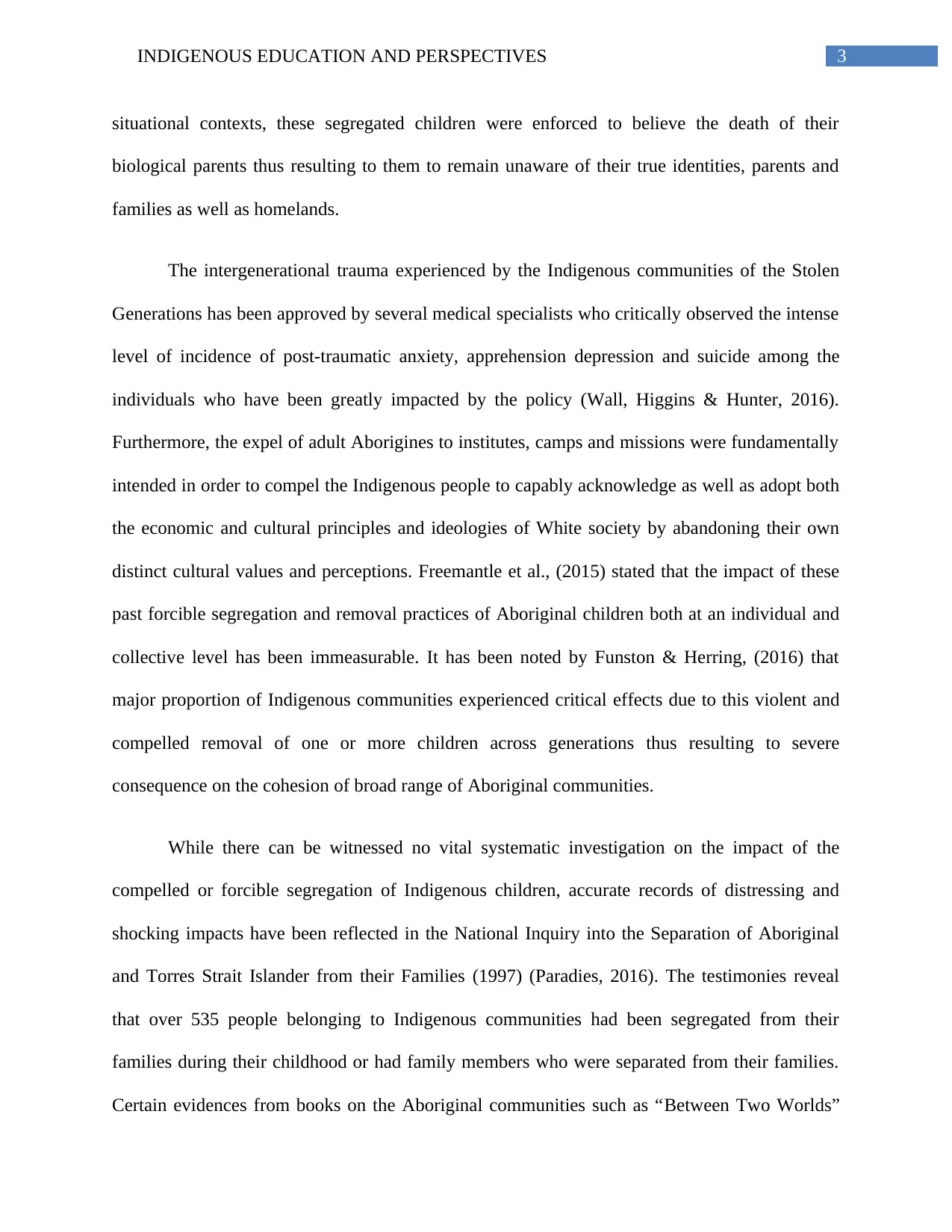
3INDIGENOUS EDUCATION AND PERSPECTIVES
situational contexts, these segregated children were enforced to believe the death of their
biological parents thus resulting to them to remain unaware of their true identities, parents and
families as well as homelands.
The intergenerational trauma experienced by the Indigenous communities of the Stolen
Generations has been approved by several medical specialists who critically observed the intense
level of incidence of post-traumatic anxiety, apprehension depression and suicide among the
individuals who have been greatly impacted by the policy (Wall, Higgins & Hunter, 2016).
Furthermore, the expel of adult Aborigines to institutes, camps and missions were fundamentally
intended in order to compel the Indigenous people to capably acknowledge as well as adopt both
the economic and cultural principles and ideologies of White society by abandoning their own
distinct cultural values and perceptions. Freemantle et al., (2015) stated that the impact of these
past forcible segregation and removal practices of Aboriginal children both at an individual and
collective level has been immeasurable. It has been noted by Funston & Herring, (2016) that
major proportion of Indigenous communities experienced critical effects due to this violent and
compelled removal of one or more children across generations thus resulting to severe
consequence on the cohesion of broad range of Aboriginal communities.
While there can be witnessed no vital systematic investigation on the impact of the
compelled or forcible segregation of Indigenous children, accurate records of distressing and
shocking impacts have been reflected in the National Inquiry into the Separation of Aboriginal
and Torres Strait Islander from their Families (1997) (Paradies, 2016). The testimonies reveal
that over 535 people belonging to Indigenous communities had been segregated from their
families during their childhood or had family members who were separated from their families.
Certain evidences from books on the Aboriginal communities such as “Between Two Worlds”
situational contexts, these segregated children were enforced to believe the death of their
biological parents thus resulting to them to remain unaware of their true identities, parents and
families as well as homelands.
The intergenerational trauma experienced by the Indigenous communities of the Stolen
Generations has been approved by several medical specialists who critically observed the intense
level of incidence of post-traumatic anxiety, apprehension depression and suicide among the
individuals who have been greatly impacted by the policy (Wall, Higgins & Hunter, 2016).
Furthermore, the expel of adult Aborigines to institutes, camps and missions were fundamentally
intended in order to compel the Indigenous people to capably acknowledge as well as adopt both
the economic and cultural principles and ideologies of White society by abandoning their own
distinct cultural values and perceptions. Freemantle et al., (2015) stated that the impact of these
past forcible segregation and removal practices of Aboriginal children both at an individual and
collective level has been immeasurable. It has been noted by Funston & Herring, (2016) that
major proportion of Indigenous communities experienced critical effects due to this violent and
compelled removal of one or more children across generations thus resulting to severe
consequence on the cohesion of broad range of Aboriginal communities.
While there can be witnessed no vital systematic investigation on the impact of the
compelled or forcible segregation of Indigenous children, accurate records of distressing and
shocking impacts have been reflected in the National Inquiry into the Separation of Aboriginal
and Torres Strait Islander from their Families (1997) (Paradies, 2016). The testimonies reveal
that over 535 people belonging to Indigenous communities had been segregated from their
families during their childhood or had family members who were separated from their families.
Certain evidences from books on the Aboriginal communities such as “Between Two Worlds”
Paraphrase This Document
Need a fresh take? Get an instant paraphrase of this document with our AI Paraphraser
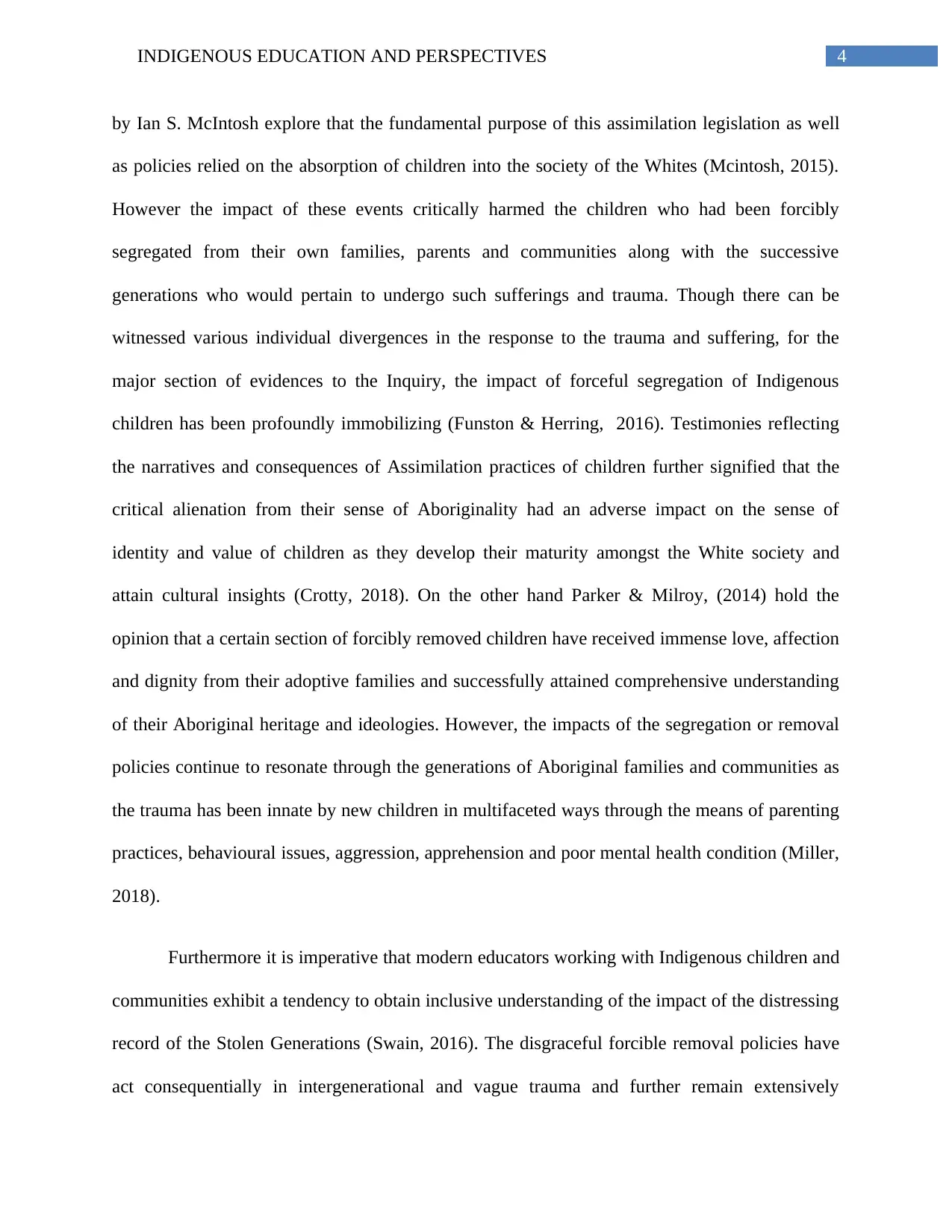
4INDIGENOUS EDUCATION AND PERSPECTIVES
by Ian S. McIntosh explore that the fundamental purpose of this assimilation legislation as well
as policies relied on the absorption of children into the society of the Whites (Mcintosh, 2015).
However the impact of these events critically harmed the children who had been forcibly
segregated from their own families, parents and communities along with the successive
generations who would pertain to undergo such sufferings and trauma. Though there can be
witnessed various individual divergences in the response to the trauma and suffering, for the
major section of evidences to the Inquiry, the impact of forceful segregation of Indigenous
children has been profoundly immobilizing (Funston & Herring, 2016). Testimonies reflecting
the narratives and consequences of Assimilation practices of children further signified that the
critical alienation from their sense of Aboriginality had an adverse impact on the sense of
identity and value of children as they develop their maturity amongst the White society and
attain cultural insights (Crotty, 2018). On the other hand Parker & Milroy, (2014) hold the
opinion that a certain section of forcibly removed children have received immense love, affection
and dignity from their adoptive families and successfully attained comprehensive understanding
of their Aboriginal heritage and ideologies. However, the impacts of the segregation or removal
policies continue to resonate through the generations of Aboriginal families and communities as
the trauma has been innate by new children in multifaceted ways through the means of parenting
practices, behavioural issues, aggression, apprehension and poor mental health condition (Miller,
2018).
Furthermore it is imperative that modern educators working with Indigenous children and
communities exhibit a tendency to obtain inclusive understanding of the impact of the distressing
record of the Stolen Generations (Swain, 2016). The disgraceful forcible removal policies have
act consequentially in intergenerational and vague trauma and further remain extensively
by Ian S. McIntosh explore that the fundamental purpose of this assimilation legislation as well
as policies relied on the absorption of children into the society of the Whites (Mcintosh, 2015).
However the impact of these events critically harmed the children who had been forcibly
segregated from their own families, parents and communities along with the successive
generations who would pertain to undergo such sufferings and trauma. Though there can be
witnessed various individual divergences in the response to the trauma and suffering, for the
major section of evidences to the Inquiry, the impact of forceful segregation of Indigenous
children has been profoundly immobilizing (Funston & Herring, 2016). Testimonies reflecting
the narratives and consequences of Assimilation practices of children further signified that the
critical alienation from their sense of Aboriginality had an adverse impact on the sense of
identity and value of children as they develop their maturity amongst the White society and
attain cultural insights (Crotty, 2018). On the other hand Parker & Milroy, (2014) hold the
opinion that a certain section of forcibly removed children have received immense love, affection
and dignity from their adoptive families and successfully attained comprehensive understanding
of their Aboriginal heritage and ideologies. However, the impacts of the segregation or removal
policies continue to resonate through the generations of Aboriginal families and communities as
the trauma has been innate by new children in multifaceted ways through the means of parenting
practices, behavioural issues, aggression, apprehension and poor mental health condition (Miller,
2018).
Furthermore it is imperative that modern educators working with Indigenous children and
communities exhibit a tendency to obtain inclusive understanding of the impact of the distressing
record of the Stolen Generations (Swain, 2016). The disgraceful forcible removal policies have
act consequentially in intergenerational and vague trauma and further remain extensively
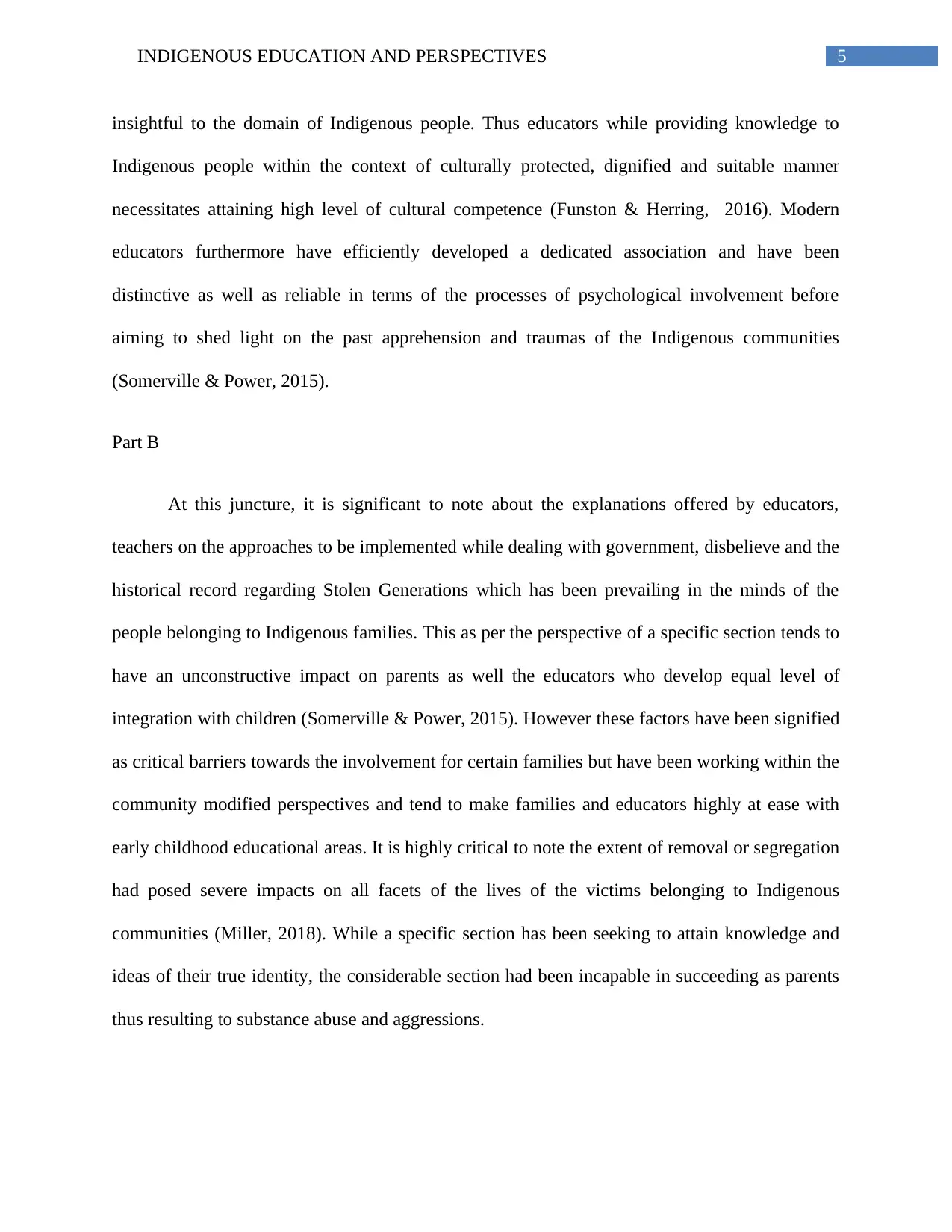
5INDIGENOUS EDUCATION AND PERSPECTIVES
insightful to the domain of Indigenous people. Thus educators while providing knowledge to
Indigenous people within the context of culturally protected, dignified and suitable manner
necessitates attaining high level of cultural competence (Funston & Herring, 2016). Modern
educators furthermore have efficiently developed a dedicated association and have been
distinctive as well as reliable in terms of the processes of psychological involvement before
aiming to shed light on the past apprehension and traumas of the Indigenous communities
(Somerville & Power, 2015).
Part B
At this juncture, it is significant to note about the explanations offered by educators,
teachers on the approaches to be implemented while dealing with government, disbelieve and the
historical record regarding Stolen Generations which has been prevailing in the minds of the
people belonging to Indigenous families. This as per the perspective of a specific section tends to
have an unconstructive impact on parents as well the educators who develop equal level of
integration with children (Somerville & Power, 2015). However these factors have been signified
as critical barriers towards the involvement for certain families but have been working within the
community modified perspectives and tend to make families and educators highly at ease with
early childhood educational areas. It is highly critical to note the extent of removal or segregation
had posed severe impacts on all facets of the lives of the victims belonging to Indigenous
communities (Miller, 2018). While a specific section has been seeking to attain knowledge and
ideas of their true identity, the considerable section had been incapable in succeeding as parents
thus resulting to substance abuse and aggressions.
insightful to the domain of Indigenous people. Thus educators while providing knowledge to
Indigenous people within the context of culturally protected, dignified and suitable manner
necessitates attaining high level of cultural competence (Funston & Herring, 2016). Modern
educators furthermore have efficiently developed a dedicated association and have been
distinctive as well as reliable in terms of the processes of psychological involvement before
aiming to shed light on the past apprehension and traumas of the Indigenous communities
(Somerville & Power, 2015).
Part B
At this juncture, it is significant to note about the explanations offered by educators,
teachers on the approaches to be implemented while dealing with government, disbelieve and the
historical record regarding Stolen Generations which has been prevailing in the minds of the
people belonging to Indigenous families. This as per the perspective of a specific section tends to
have an unconstructive impact on parents as well the educators who develop equal level of
integration with children (Somerville & Power, 2015). However these factors have been signified
as critical barriers towards the involvement for certain families but have been working within the
community modified perspectives and tend to make families and educators highly at ease with
early childhood educational areas. It is highly critical to note the extent of removal or segregation
had posed severe impacts on all facets of the lives of the victims belonging to Indigenous
communities (Miller, 2018). While a specific section has been seeking to attain knowledge and
ideas of their true identity, the considerable section had been incapable in succeeding as parents
thus resulting to substance abuse and aggressions.
⊘ This is a preview!⊘
Do you want full access?
Subscribe today to unlock all pages.

Trusted by 1+ million students worldwide
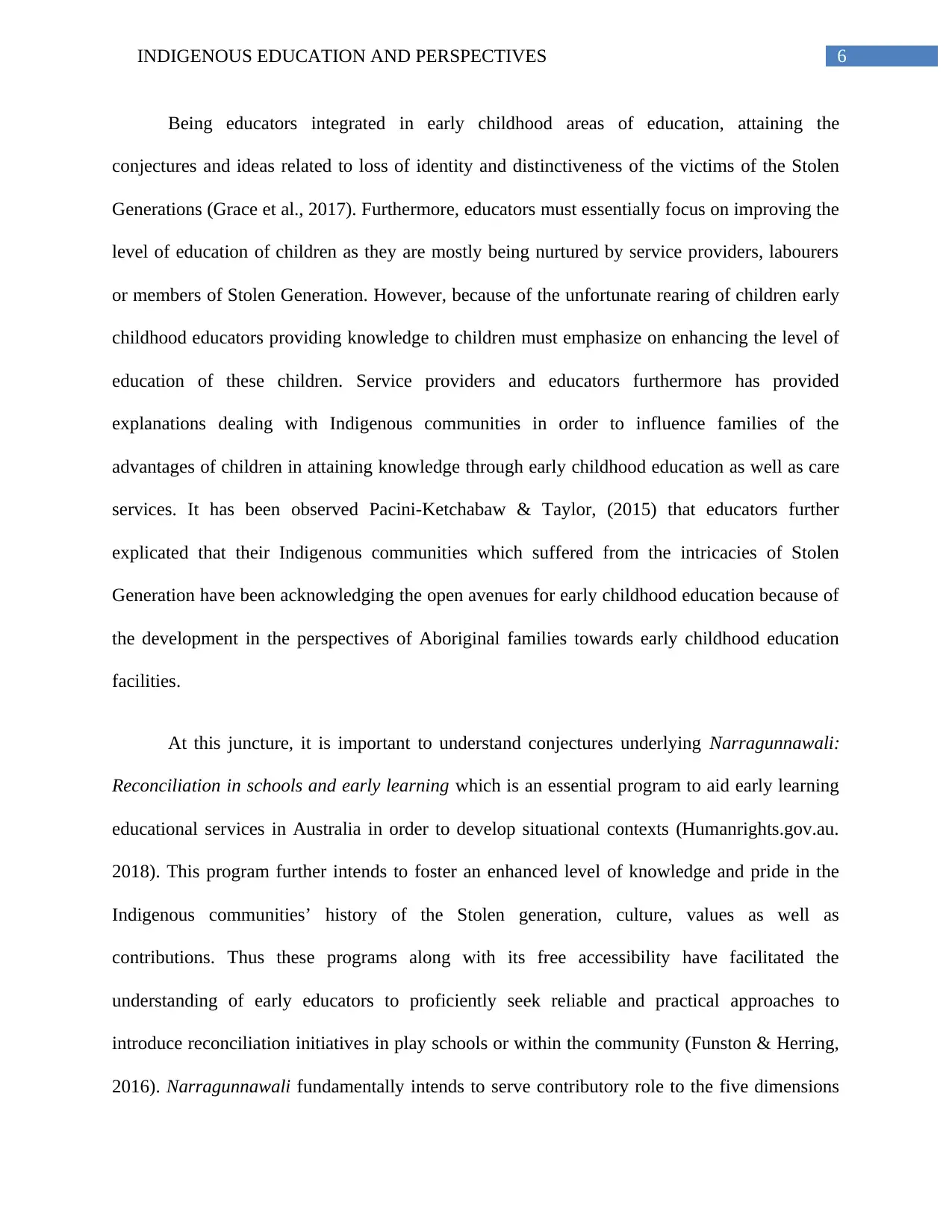
6INDIGENOUS EDUCATION AND PERSPECTIVES
Being educators integrated in early childhood areas of education, attaining the
conjectures and ideas related to loss of identity and distinctiveness of the victims of the Stolen
Generations (Grace et al., 2017). Furthermore, educators must essentially focus on improving the
level of education of children as they are mostly being nurtured by service providers, labourers
or members of Stolen Generation. However, because of the unfortunate rearing of children early
childhood educators providing knowledge to children must emphasize on enhancing the level of
education of these children. Service providers and educators furthermore has provided
explanations dealing with Indigenous communities in order to influence families of the
advantages of children in attaining knowledge through early childhood education as well as care
services. It has been observed Pacini-Ketchabaw & Taylor, (2015) that educators further
explicated that their Indigenous communities which suffered from the intricacies of Stolen
Generation have been acknowledging the open avenues for early childhood education because of
the development in the perspectives of Aboriginal families towards early childhood education
facilities.
At this juncture, it is important to understand conjectures underlying Narragunnawali:
Reconciliation in schools and early learning which is an essential program to aid early learning
educational services in Australia in order to develop situational contexts (Humanrights.gov.au.
2018). This program further intends to foster an enhanced level of knowledge and pride in the
Indigenous communities’ history of the Stolen generation, culture, values as well as
contributions. Thus these programs along with its free accessibility have facilitated the
understanding of early educators to proficiently seek reliable and practical approaches to
introduce reconciliation initiatives in play schools or within the community (Funston & Herring,
2016). Narragunnawali fundamentally intends to serve contributory role to the five dimensions
Being educators integrated in early childhood areas of education, attaining the
conjectures and ideas related to loss of identity and distinctiveness of the victims of the Stolen
Generations (Grace et al., 2017). Furthermore, educators must essentially focus on improving the
level of education of children as they are mostly being nurtured by service providers, labourers
or members of Stolen Generation. However, because of the unfortunate rearing of children early
childhood educators providing knowledge to children must emphasize on enhancing the level of
education of these children. Service providers and educators furthermore has provided
explanations dealing with Indigenous communities in order to influence families of the
advantages of children in attaining knowledge through early childhood education as well as care
services. It has been observed Pacini-Ketchabaw & Taylor, (2015) that educators further
explicated that their Indigenous communities which suffered from the intricacies of Stolen
Generation have been acknowledging the open avenues for early childhood education because of
the development in the perspectives of Aboriginal families towards early childhood education
facilities.
At this juncture, it is important to understand conjectures underlying Narragunnawali:
Reconciliation in schools and early learning which is an essential program to aid early learning
educational services in Australia in order to develop situational contexts (Humanrights.gov.au.
2018). This program further intends to foster an enhanced level of knowledge and pride in the
Indigenous communities’ history of the Stolen generation, culture, values as well as
contributions. Thus these programs along with its free accessibility have facilitated the
understanding of early educators to proficiently seek reliable and practical approaches to
introduce reconciliation initiatives in play schools or within the community (Funston & Herring,
2016). Narragunnawali fundamentally intends to serve contributory role to the five dimensions
Paraphrase This Document
Need a fresh take? Get an instant paraphrase of this document with our AI Paraphraser
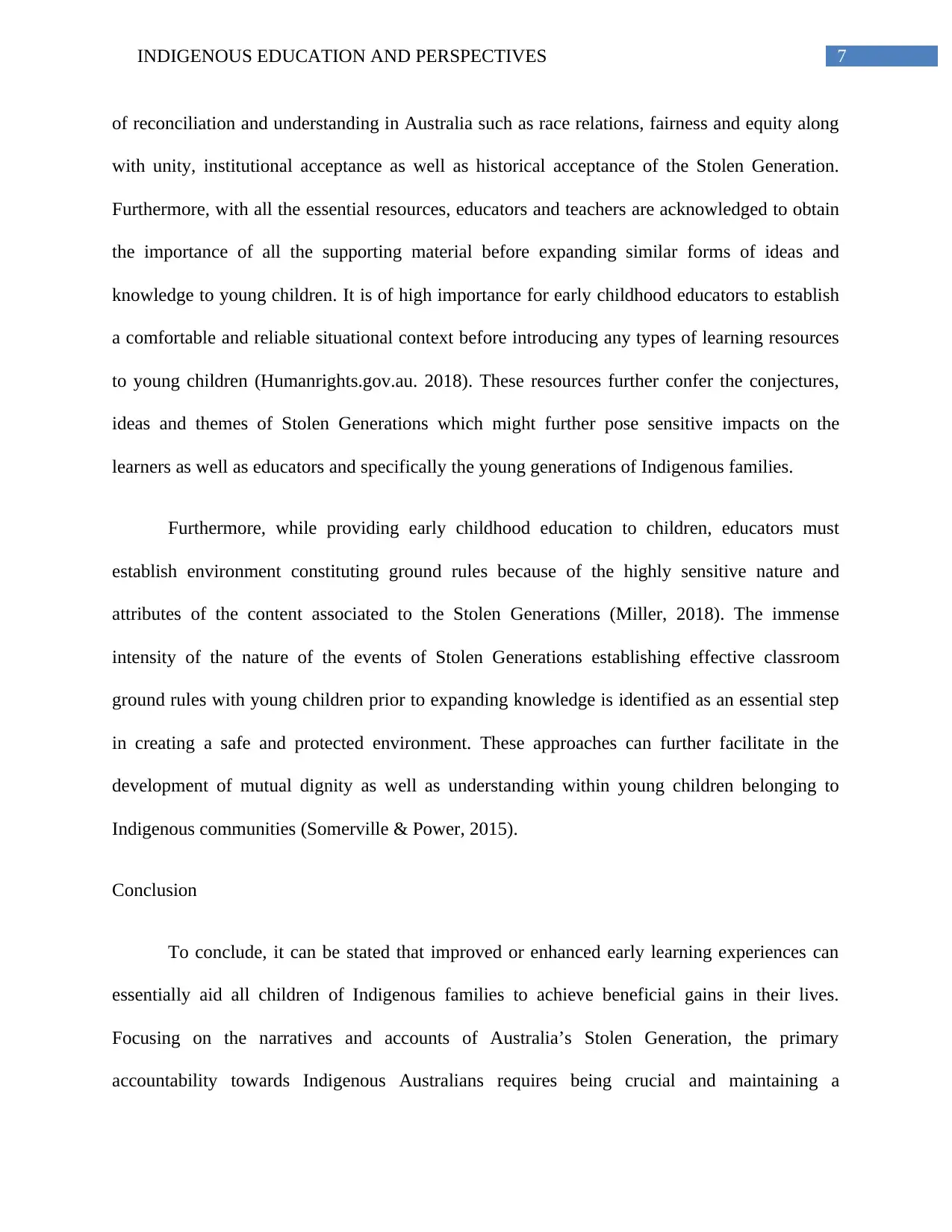
7INDIGENOUS EDUCATION AND PERSPECTIVES
of reconciliation and understanding in Australia such as race relations, fairness and equity along
with unity, institutional acceptance as well as historical acceptance of the Stolen Generation.
Furthermore, with all the essential resources, educators and teachers are acknowledged to obtain
the importance of all the supporting material before expanding similar forms of ideas and
knowledge to young children. It is of high importance for early childhood educators to establish
a comfortable and reliable situational context before introducing any types of learning resources
to young children (Humanrights.gov.au. 2018). These resources further confer the conjectures,
ideas and themes of Stolen Generations which might further pose sensitive impacts on the
learners as well as educators and specifically the young generations of Indigenous families.
Furthermore, while providing early childhood education to children, educators must
establish environment constituting ground rules because of the highly sensitive nature and
attributes of the content associated to the Stolen Generations (Miller, 2018). The immense
intensity of the nature of the events of Stolen Generations establishing effective classroom
ground rules with young children prior to expanding knowledge is identified as an essential step
in creating a safe and protected environment. These approaches can further facilitate in the
development of mutual dignity as well as understanding within young children belonging to
Indigenous communities (Somerville & Power, 2015).
Conclusion
To conclude, it can be stated that improved or enhanced early learning experiences can
essentially aid all children of Indigenous families to achieve beneficial gains in their lives.
Focusing on the narratives and accounts of Australia’s Stolen Generation, the primary
accountability towards Indigenous Australians requires being crucial and maintaining a
of reconciliation and understanding in Australia such as race relations, fairness and equity along
with unity, institutional acceptance as well as historical acceptance of the Stolen Generation.
Furthermore, with all the essential resources, educators and teachers are acknowledged to obtain
the importance of all the supporting material before expanding similar forms of ideas and
knowledge to young children. It is of high importance for early childhood educators to establish
a comfortable and reliable situational context before introducing any types of learning resources
to young children (Humanrights.gov.au. 2018). These resources further confer the conjectures,
ideas and themes of Stolen Generations which might further pose sensitive impacts on the
learners as well as educators and specifically the young generations of Indigenous families.
Furthermore, while providing early childhood education to children, educators must
establish environment constituting ground rules because of the highly sensitive nature and
attributes of the content associated to the Stolen Generations (Miller, 2018). The immense
intensity of the nature of the events of Stolen Generations establishing effective classroom
ground rules with young children prior to expanding knowledge is identified as an essential step
in creating a safe and protected environment. These approaches can further facilitate in the
development of mutual dignity as well as understanding within young children belonging to
Indigenous communities (Somerville & Power, 2015).
Conclusion
To conclude, it can be stated that improved or enhanced early learning experiences can
essentially aid all children of Indigenous families to achieve beneficial gains in their lives.
Focusing on the narratives and accounts of Australia’s Stolen Generation, the primary
accountability towards Indigenous Australians requires being crucial and maintaining a
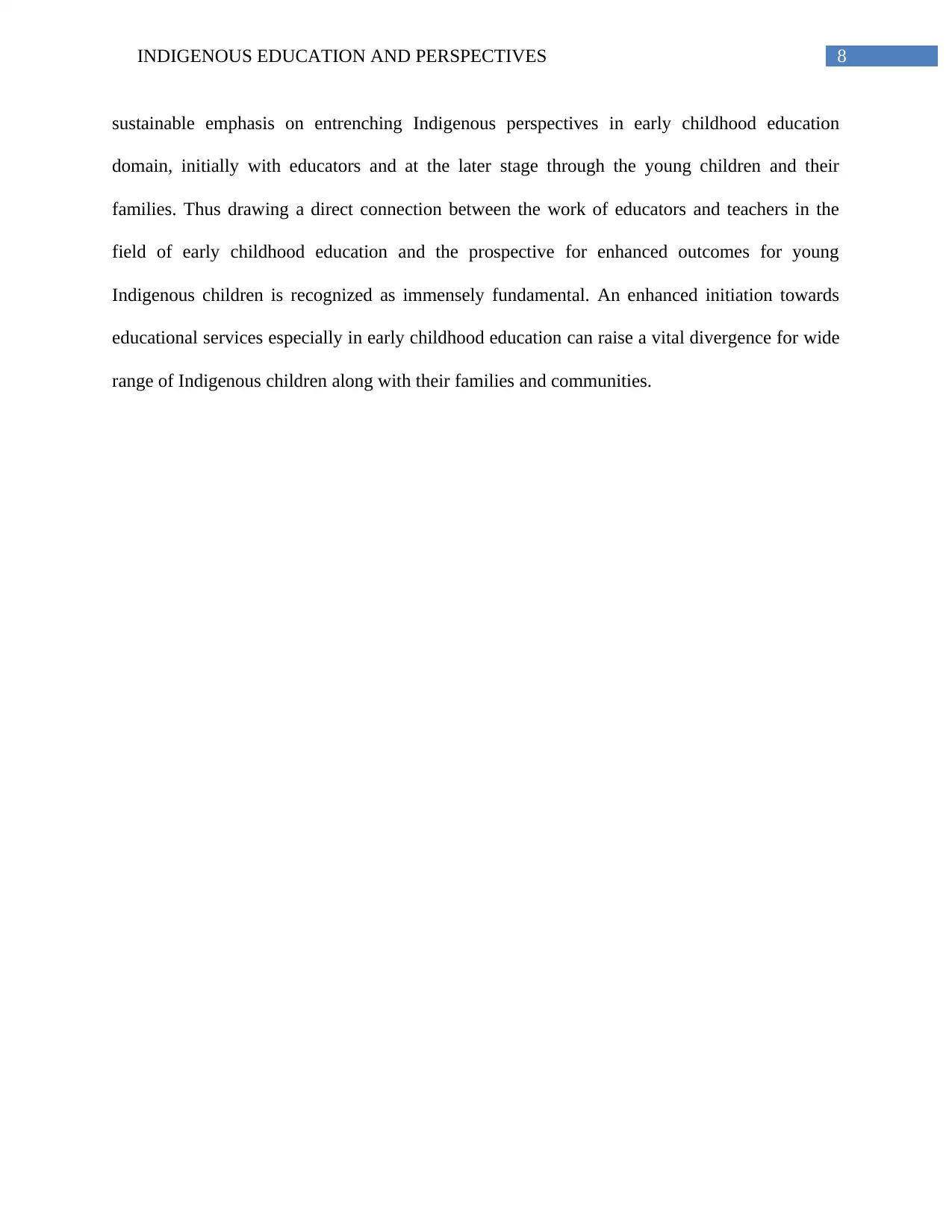
8INDIGENOUS EDUCATION AND PERSPECTIVES
sustainable emphasis on entrenching Indigenous perspectives in early childhood education
domain, initially with educators and at the later stage through the young children and their
families. Thus drawing a direct connection between the work of educators and teachers in the
field of early childhood education and the prospective for enhanced outcomes for young
Indigenous children is recognized as immensely fundamental. An enhanced initiation towards
educational services especially in early childhood education can raise a vital divergence for wide
range of Indigenous children along with their families and communities.
sustainable emphasis on entrenching Indigenous perspectives in early childhood education
domain, initially with educators and at the later stage through the young children and their
families. Thus drawing a direct connection between the work of educators and teachers in the
field of early childhood education and the prospective for enhanced outcomes for young
Indigenous children is recognized as immensely fundamental. An enhanced initiation towards
educational services especially in early childhood education can raise a vital divergence for wide
range of Indigenous children along with their families and communities.
⊘ This is a preview!⊘
Do you want full access?
Subscribe today to unlock all pages.

Trusted by 1+ million students worldwide
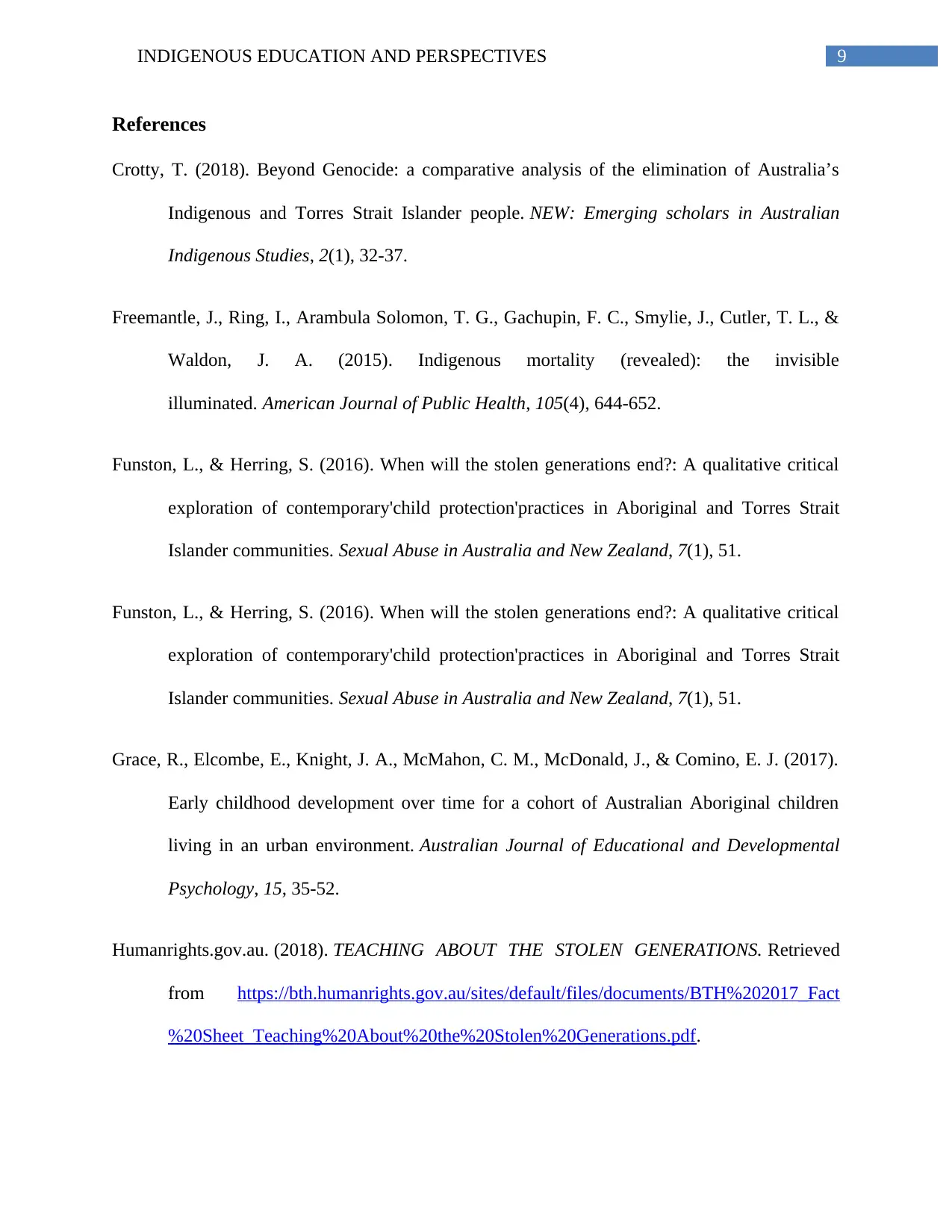
9INDIGENOUS EDUCATION AND PERSPECTIVES
References
Crotty, T. (2018). Beyond Genocide: a comparative analysis of the elimination of Australia’s
Indigenous and Torres Strait Islander people. NEW: Emerging scholars in Australian
Indigenous Studies, 2(1), 32-37.
Freemantle, J., Ring, I., Arambula Solomon, T. G., Gachupin, F. C., Smylie, J., Cutler, T. L., &
Waldon, J. A. (2015). Indigenous mortality (revealed): the invisible
illuminated. American Journal of Public Health, 105(4), 644-652.
Funston, L., & Herring, S. (2016). When will the stolen generations end?: A qualitative critical
exploration of contemporary'child protection'practices in Aboriginal and Torres Strait
Islander communities. Sexual Abuse in Australia and New Zealand, 7(1), 51.
Funston, L., & Herring, S. (2016). When will the stolen generations end?: A qualitative critical
exploration of contemporary'child protection'practices in Aboriginal and Torres Strait
Islander communities. Sexual Abuse in Australia and New Zealand, 7(1), 51.
Grace, R., Elcombe, E., Knight, J. A., McMahon, C. M., McDonald, J., & Comino, E. J. (2017).
Early childhood development over time for a cohort of Australian Aboriginal children
living in an urban environment. Australian Journal of Educational and Developmental
Psychology, 15, 35-52.
Humanrights.gov.au. (2018). TEACHING ABOUT THE STOLEN GENERATIONS. Retrieved
from https://bth.humanrights.gov.au/sites/default/files/documents/BTH%202017_Fact
%20Sheet_Teaching%20About%20the%20Stolen%20Generations.pdf.
References
Crotty, T. (2018). Beyond Genocide: a comparative analysis of the elimination of Australia’s
Indigenous and Torres Strait Islander people. NEW: Emerging scholars in Australian
Indigenous Studies, 2(1), 32-37.
Freemantle, J., Ring, I., Arambula Solomon, T. G., Gachupin, F. C., Smylie, J., Cutler, T. L., &
Waldon, J. A. (2015). Indigenous mortality (revealed): the invisible
illuminated. American Journal of Public Health, 105(4), 644-652.
Funston, L., & Herring, S. (2016). When will the stolen generations end?: A qualitative critical
exploration of contemporary'child protection'practices in Aboriginal and Torres Strait
Islander communities. Sexual Abuse in Australia and New Zealand, 7(1), 51.
Funston, L., & Herring, S. (2016). When will the stolen generations end?: A qualitative critical
exploration of contemporary'child protection'practices in Aboriginal and Torres Strait
Islander communities. Sexual Abuse in Australia and New Zealand, 7(1), 51.
Grace, R., Elcombe, E., Knight, J. A., McMahon, C. M., McDonald, J., & Comino, E. J. (2017).
Early childhood development over time for a cohort of Australian Aboriginal children
living in an urban environment. Australian Journal of Educational and Developmental
Psychology, 15, 35-52.
Humanrights.gov.au. (2018). TEACHING ABOUT THE STOLEN GENERATIONS. Retrieved
from https://bth.humanrights.gov.au/sites/default/files/documents/BTH%202017_Fact
%20Sheet_Teaching%20About%20the%20Stolen%20Generations.pdf.
Paraphrase This Document
Need a fresh take? Get an instant paraphrase of this document with our AI Paraphraser
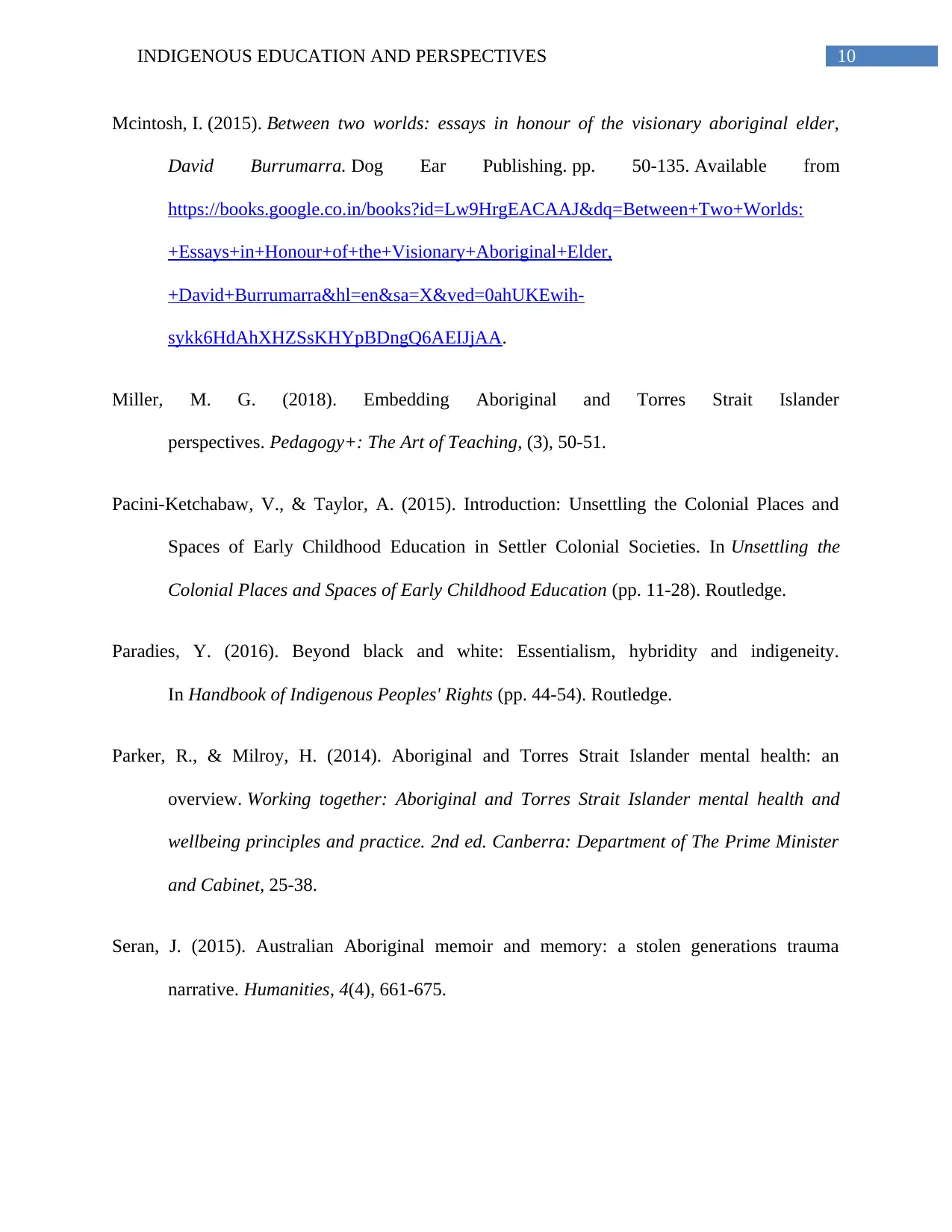
10INDIGENOUS EDUCATION AND PERSPECTIVES
Mcintosh, I. (2015). Between two worlds: essays in honour of the visionary aboriginal elder,
David Burrumarra. Dog Ear Publishing. pp. 50-135. Available from
https://books.google.co.in/books?id=Lw9HrgEACAAJ&dq=Between+Two+Worlds:
+Essays+in+Honour+of+the+Visionary+Aboriginal+Elder,
+David+Burrumarra&hl=en&sa=X&ved=0ahUKEwih-
sykk6HdAhXHZSsKHYpBDngQ6AEIJjAA.
Miller, M. G. (2018). Embedding Aboriginal and Torres Strait Islander
perspectives. Pedagogy+: The Art of Teaching, (3), 50-51.
Pacini-Ketchabaw, V., & Taylor, A. (2015). Introduction: Unsettling the Colonial Places and
Spaces of Early Childhood Education in Settler Colonial Societies. In Unsettling the
Colonial Places and Spaces of Early Childhood Education (pp. 11-28). Routledge.
Paradies, Y. (2016). Beyond black and white: Essentialism, hybridity and indigeneity.
In Handbook of Indigenous Peoples' Rights (pp. 44-54). Routledge.
Parker, R., & Milroy, H. (2014). Aboriginal and Torres Strait Islander mental health: an
overview. Working together: Aboriginal and Torres Strait Islander mental health and
wellbeing principles and practice. 2nd ed. Canberra: Department of The Prime Minister
and Cabinet, 25-38.
Seran, J. (2015). Australian Aboriginal memoir and memory: a stolen generations trauma
narrative. Humanities, 4(4), 661-675.
Mcintosh, I. (2015). Between two worlds: essays in honour of the visionary aboriginal elder,
David Burrumarra. Dog Ear Publishing. pp. 50-135. Available from
https://books.google.co.in/books?id=Lw9HrgEACAAJ&dq=Between+Two+Worlds:
+Essays+in+Honour+of+the+Visionary+Aboriginal+Elder,
+David+Burrumarra&hl=en&sa=X&ved=0ahUKEwih-
sykk6HdAhXHZSsKHYpBDngQ6AEIJjAA.
Miller, M. G. (2018). Embedding Aboriginal and Torres Strait Islander
perspectives. Pedagogy+: The Art of Teaching, (3), 50-51.
Pacini-Ketchabaw, V., & Taylor, A. (2015). Introduction: Unsettling the Colonial Places and
Spaces of Early Childhood Education in Settler Colonial Societies. In Unsettling the
Colonial Places and Spaces of Early Childhood Education (pp. 11-28). Routledge.
Paradies, Y. (2016). Beyond black and white: Essentialism, hybridity and indigeneity.
In Handbook of Indigenous Peoples' Rights (pp. 44-54). Routledge.
Parker, R., & Milroy, H. (2014). Aboriginal and Torres Strait Islander mental health: an
overview. Working together: Aboriginal and Torres Strait Islander mental health and
wellbeing principles and practice. 2nd ed. Canberra: Department of The Prime Minister
and Cabinet, 25-38.
Seran, J. (2015). Australian Aboriginal memoir and memory: a stolen generations trauma
narrative. Humanities, 4(4), 661-675.
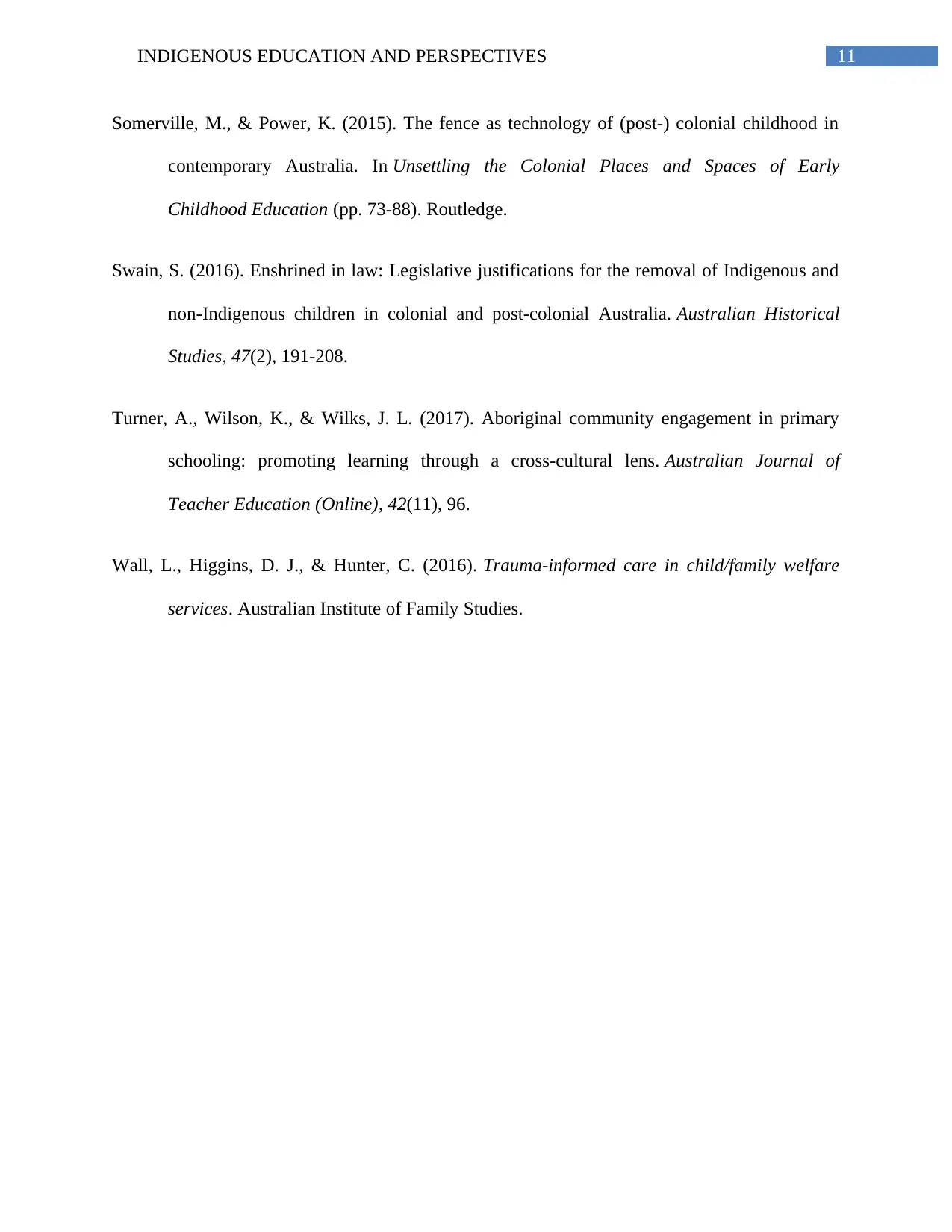
11INDIGENOUS EDUCATION AND PERSPECTIVES
Somerville, M., & Power, K. (2015). The fence as technology of (post-) colonial childhood in
contemporary Australia. In Unsettling the Colonial Places and Spaces of Early
Childhood Education (pp. 73-88). Routledge.
Swain, S. (2016). Enshrined in law: Legislative justifications for the removal of Indigenous and
non-Indigenous children in colonial and post-colonial Australia. Australian Historical
Studies, 47(2), 191-208.
Turner, A., Wilson, K., & Wilks, J. L. (2017). Aboriginal community engagement in primary
schooling: promoting learning through a cross-cultural lens. Australian Journal of
Teacher Education (Online), 42(11), 96.
Wall, L., Higgins, D. J., & Hunter, C. (2016). Trauma-informed care in child/family welfare
services. Australian Institute of Family Studies.
Somerville, M., & Power, K. (2015). The fence as technology of (post-) colonial childhood in
contemporary Australia. In Unsettling the Colonial Places and Spaces of Early
Childhood Education (pp. 73-88). Routledge.
Swain, S. (2016). Enshrined in law: Legislative justifications for the removal of Indigenous and
non-Indigenous children in colonial and post-colonial Australia. Australian Historical
Studies, 47(2), 191-208.
Turner, A., Wilson, K., & Wilks, J. L. (2017). Aboriginal community engagement in primary
schooling: promoting learning through a cross-cultural lens. Australian Journal of
Teacher Education (Online), 42(11), 96.
Wall, L., Higgins, D. J., & Hunter, C. (2016). Trauma-informed care in child/family welfare
services. Australian Institute of Family Studies.
⊘ This is a preview!⊘
Do you want full access?
Subscribe today to unlock all pages.

Trusted by 1+ million students worldwide
1 out of 12
Related Documents
Your All-in-One AI-Powered Toolkit for Academic Success.
+13062052269
info@desklib.com
Available 24*7 on WhatsApp / Email
![[object Object]](/_next/static/media/star-bottom.7253800d.svg)
Unlock your academic potential
Copyright © 2020–2025 A2Z Services. All Rights Reserved. Developed and managed by ZUCOL.





